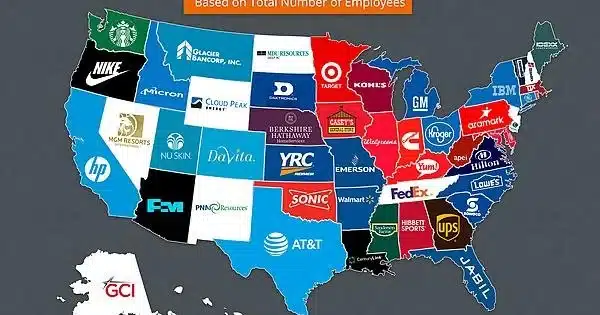When we think of the largest companies in the United States, names like Apple, Amazon, Microsoft, and Alphabet immediately come to mind. But what’s remarkable is how the dynamics have changed since 2020. These companies have not only maintained, but also increased their supremacy in the face of new technical developments, altering consumer preferences, and global disruptions. So, we’ll be analyzing the largest companies in the United States and the driving cause behind their success.
What Are the Largest Companies in the United States in 2024?
Here are the largest United States companies in 2024, based on market capitalization and global influence:
- Apple has a $3.1 trillion market capitalization.
- Microsoft has a $2.6 trillion market capitalization.
- Amazon has a $1.8 trillion market capitalization.
- Alphabet (Google’s Parent Company) – Market capitalization: $1.7 trillion
- Tesla has a $1.4 trillion market capitalization.
Let us take a closer look at each of these companies to see what makes them the powerhouses they are today.
#1. Apple

Apple continues to dominate in 2024, with a market value of more than $3.1 trillion. What many people don’t realize is that Apple’s evolution has extended far beyond iPhones, iPads, and Macs. Here’s what distinguishes it:
1. Product Lines:
Apple’s most well-known products are the iPhone, iPad, and Mac. These items remain at the heart of the company’s success, producing enormous revenue worldwide. However, it is easy to miss what happens outside of the hardware.
2. Service Division:
- iCloud: Apple’s cloud storage service connects with its complete product line, allowing for seamless data management.
- Apple Pay: Apple has made mobile payments a part of everyday life, with millions of people utilizing Apple Pay for online and in-store purchases.
- Health Tech Initiatives: Apple is expanding into the health space with innovations such as the Apple Watch’s health monitoring functions, establishing itself as a personal wellness leader rather than just a technology firm.
- $90 billion in Services Revenue: In 2024, Apple’s services sector alone generated more than $90 billion, accounting for a significant portion of the company’s total revenue—an area experts frequently ignore when analyzing Apple’s supremacy.
Apple’s ecosystem-building strategy is crucial. The business assures that once you’re in its system, with your iPhone connected to iCloud and payments handled through Apple Pay, it’s difficult to escape. That stickiness is what keeps people—and their money—close.
#2. Microsoft

Microsoft, with a market valuation of $2.6 trillion, has cemented its position not only in technology but in almost every business that relies on cloud computing and AI-driven solutions. The company’s focus has switched from traditional software to something far more forward-looking. Here’s how.
1. Cloud Infrastructure (Azure)
Azure continues to grow at double-digit rates year after year, establishing Microsoft as a leader in cloud computing services. Azure’s extensive adoption across industries demonstrates its value in current technology architecture.
2. Artificial intelligence and machine learning
- Microsoft’s significant investment in AI and machine learning is more than just staying up; it is about leading. AI-powered solutions are at the heart of innovative products and services, including predictive analytics and automation.
3. Strategic acquisitions
Microsoft’s latest acquisitions in healthcare and industrial production are preparing the corporation for future dominance. These acquisitions demonstrate Microsoft’s desire to extend far beyond its conventional technology origins into areas ripe for the digital revolution.
What is frequently forgotten is the internet titans’ ecosystem-building strategy. Take Microsoft 365 as an example:
- Subscription models:
Instead of single purchases, Microsoft, Apple, and Amazon rely on subscription services to generate regular revenue. These include Microsoft Office 365, Amazon Prime, and Apple’s many subscription services, such as iCloud and Apple Music. - Platform Approach:
Each company has created integrated ecosystems. Apple’s ecosystem consists of devices and services that function in tandem, Amazon’s Prime subscribers are linked to a variety of services, and Microsoft’s cloud and software platforms bind organizations to their ecosystems indefinitely.
These solutions generate more predictable revenue streams and reduce the companies’ exposure to market volatility. In other words, they’re designed to withstand storms.
#3. Amazon

When people think of Amazon, they frequently consider its e-commerce dominance. But what truly distinguishes Amazon is the sheer scope of its activities. Amazon’s market valuation will reach $1.8 trillion by 2024, and this is due to more than simply Prime Day bargains. Let us break it down:
- Amazon Web Services (AWS): AWS remains the unchallenged leader in cloud computing. It powers a substantial percentage of the internet, from small start-ups to multinational corporations. In 2024, AWS alone generated more than $80 billion in revenue, demonstrating that Amazon is more than just an online store.
- Advertising Powerhouse: What is sometimes overlooked is the growth of Amazon’s advertising division, which produced more than $50 billion this year. Companies use Amazon’s data to generate hyper-targeted advertisements, allowing Amazon to compete directly with Google and Facebook in the advertising market.
Amazon is also making ripples in other industries, including logistics, entertainment (Prime Video), and healthcare. Its diversified portfolio and constant innovation help it stay ahead of the competition.
#4. Alphabet (Google’s parent company)

Alphabet, Google’s parent corporation, remains a dominant force, with a $1.7 trillion market capitalization in 2024. But Google is no longer simply about search. Here are the areas that drive its growth:
- Google Cloud: Similar to Microsoft and Amazon, Alphabet’s expansion into cloud computing is noteworthy. Google Cloud may not have as much market share as AWS or Azure, but it is becoming an important player, particularly in the AI-driven service industry.
- Artificial Intelligence: Alphabet’s investment in AI has propelled it ahead of several competitors. Google’s DeepMind and TensorFlow are at the forefront of AI research and applications, including natural language processing and self-driving automobiles.
- YouTube: Do not forget about YouTube, the world’s second-largest search engine. The platform continues to be a cash cow for Alphabet, generating billions of dollars in ad revenue annually.
In 2024, Alphabet’s influence will extend beyond its status as an internet corporation. It is a market leader in digital advertising, artificial intelligence, and even healthcare research, making it one of the most active organizations in the world.
#5. Tesla

Tesla rounds out the top five, with a market capitalization of $1.4 trillion. Tesla’s growth has been nothing short of spectacular, from a niche electric vehicle (EV) maker to a global leader in renewable energy and technology. What stands out in 2024:
- Electric Vehicles: Tesla remains the dominant player in the EV business, selling millions of vehicles each year. The Model 3 and Model Y dominate, while the Cybertruck and Semi have sparked the most interest.
- Energy Solutions: Tesla’s reach extends beyond automobiles. Its efforts in battery technology and solar energy are part of a larger drive toward renewable energy solutions, cementing its position as a sustainability leader.
- Autonomous Driving: Tesla is at the forefront of autonomous vehicle technology, and with regulatory permissions in more regions, 2024 could be the year Tesla eventually deploys completely self-driving cars on a large scale.
#6. Berkshire Hathaway: The Investment Behemoth

- Market Cap: $780 billion.
- Revenue: $420 billion.
Berkshire Hathaway is widely regarded as the “silent giant” of the economic world. Warren Buffett’s renowned investment company, Berkshire Hathaway, is distinctive in that it consists of a variety of businesses, ranging from railroads to insurance and everything in between. The key components of its empire are:
- Insurance (GEICO): GEICO, one of the most well-known insurance companies in the United States, is a Berkshire subsidiary, which contributes significantly to the company’s consistent revenue.
- Railroad (BNSF Railway): As one of North America’s largest freight railroad networks, BNSF ensures Berkshire Hathaway’s strong presence in the transportation and logistics industry.
- Energy: Berkshire Hathaway Energy offers sustainable energy solutions and is investing in renewable energy technologies, which is a critical area for the future.
Berkshire Hathaway’s diverse portfolio, which includes investments in Apple and Coca-Cola, provides it with a strong financial foundation, making it less sensitive to industry-specific downturns. It’s the epitome of strategic, long-term investment.
#7. Meta Platforms (formerly Facebook)

- Market Cap is $780 billion.
- Revenue: $130 billion.
Meta remains a driving force in social networking and virtual reality, despite regulatory scrutiny and hurdles. In 2024, Meta is focused primarily on its Metaverse vision, which envisions a vast virtual realm in which users can communicate, collaborate, and play.
- Facebook & Instagram: These two platforms remain dominating, with Facebook having over 2.9 billion monthly active users and Instagram leading in the influencer and social commerce spaces.
- WhatsApp: Meta’s messaging platform links over 2 billion users worldwide, making it the most popular messaging app for both personal and professional use.
- Metaverse Expansion: Meta’s Oculus headsets and investments in virtual reality (VR) technologies are expected to transform how people socialize and do business online. Meta’s virtual space projects are generating tremendous excitement in 2024, although profitability remains a concern.
Meta is also a digital advertising giant, with ad sales topping $115 billion, enabling businesses of all sizes to precisely target viewers.
#8. Walmart: The Omnichannel Retail Titan

- Market Cap is $440 billion.
- Revenue: $610 billion.
Walmart remains the world’s largest company by revenue, with a projected revenue of more than $610 billion in 2024. But what distinguishes Walmart today is its successful transition to an omnichannel approach, which combines its extensive physical presence with sophisticated online services.
- E-commerce: Walmart’s online sales have increased dramatically, with Walmart+ vying with Amazon Prime for rapid delivery and exclusive discounts. Its e-commerce business generated more than $80 billion in 2024.
- Grocery Dominance: Walmart is the largest grocer in the United States, supplying millions of customers through a combination of in-store, curbside pickup, and delivery choices.
- Financial Services: Walmart is entering the fintech area by offering Walmart MoneyCard and financial services in shops, allowing customers to manage their funds directly through its ecosystem.
Walmart’s ability to adapt to changing purchasing trends while capitalizing on its supply chain advantages has kept it at the top of the retail food chain.
#9. ExxonMobil: The Energy Giant Shifts to Sustainability

- Market Cap is $500 billion.
- Revenue: $450 billion.
ExxonMobil remains one of the world’s largest oil and gas companies, but it is also shifting its focus to sustainable energy solutions as the industry is under growing scrutiny for climate change.
- Oil and Gas: ExxonMobil remains a leader in oil exploration and production, particularly in high-yield regions such as the Permian Basin. Its integrated energy portfolio ranges from drilling to refining.
- Renewable Energy Investments: With a focus on the future, ExxonMobil has made significant investments in carbon capture technology and biofuels, intending to decrease its carbon footprint and adapt to global energy transitions.
- Petrochemicals: In addition to oil, ExxonMobil’s petrochemical segment manufactures key products needed in a wide range of industries, including electronics and plastics.
Despite the urge to become green, ExxonMobil’s financial power and global reach place it among the world’s most prominent energy companies.
#10. Johnson & Johnson

- Market Cap: $500 billion.
- Revenue: $100 billion.
Johnson & Johnson is a global healthcare giant, with activities in medicines, medical equipment, and consumer health goods. Here’s what makes it an important player in 2024:
- Pharmaceuticals: J&J’s pharmaceutical segment, which includes blockbuster pharmaceuticals like Stelara and Remicade, is one of the company’s largest revenue generators, contributing more than $50 billion every year.
- Medical Devices: With goods used in everything from knee replacements to cardiovascular surgery, J&J leads the medical device business.
- Consumer Health: The company’s consumer segment contains well-known brands such as Tylenol, Band-Aid, and Neutrogena, which have helped it become a household name worldwide.
With an increasing focus on biosimilars and customized medicine, J&J’s expertise in new healthcare solutions guarantees that it remains a powerful force.
How Do the Largest U.S. Companies Revenue Compare to Market Capitalization?
To give you a sense of scale, here are the top five largest US companies by market capitalization in 2024:
- Apple: $3.1 trillion
- Microsoft: $2.6 trillion
- Amazon: $1.8 trillion
- Alphabet (Google’s parent company): $1.7 trillion.
- Tesla: $1.4 trillion
It’s interesting to note that, while market capitalization is a good indicator of a company’s value in the eyes of investors, revenue tells a different story. Walmart, for example, remains the largest revenue-generating firm in the United States, with over $600 billion in revenue expected in 2024, thanks mostly to its omnichannel strategy. Walmart does not receive the same level of attention as IT behemoths, but its unwavering focus on supply chain optimization and customer experience has helped it maintain its leading position.
Even Berkshire Hathaway, widely regarded as a slow-moving behemoth, has used its investments in technology (particularly in Apple) and energy to generate more than $400 billion in yearly income. Berkshire’s diverse portfolio ensures that it remains a force to be reckoned with in industries such as insurance and railroads.
What Makes These Companies Stand Out?
Aside from their size, what sets these companies apart is their unwavering focus on data-driven decision-making, vertical integration, and platform strength.
For example, I work with companies that want to imitate Amazon’s success. It’s not about the speed of delivery; it’s about the facts. Amazon understands what its customers want before they do. It has spent billions on AI and predictive analytics to improve everything from inventory management to ad targeting.
Similarly, Microsoft’s supremacy in cloud computing is more than just providing storage space. It is about providing a comprehensive ecosystem of services, ranging from cybersecurity to AI-powered analytics. Azure drives businesses across industries, whether it’s helping healthcare providers improve patient outcomes or allowing manufacturing to automate processes.
While many people pay attention to the obvious—revenue, market capitalization, and stock performance—the underlying causes fueling these companies’ success are frequently overlooked.
- Patents and Intellectual Property: For example, Amazon has surreptitiously acquired over 1,000 AI-related patents, providing it a competitive advantage in everything from supply chain logistics to customer service automation.
- M&A Strategy: Microsoft’s $69 billion acquisition of Activision Blizzard isn’t just about gaming; it’s a direct bet on the future of the metaverse and online ecosystems.
- Global Reach: Companies such as Apple and Tesla have mastered the art of entering emerging markets. In 2024, more than 65% of Apple’s income will originate from outside the United States, primarily in Asia.
Key Takeaways
- Market capitalization might provide a more accurate representation of a company’s future potential.
- Companies like Amazon and Tesla thrive by controlling every part of their supply chain.
- The tech titans of 2024 have all made significant investments in cloud infrastructure and AI.
- The largest U.S. companies have infiltrated practically every market internationally, increasing their power.
- Apple’s services, Amazon’s ad division, and Microsoft’s cloud platforms all demonstrate the value of recurring revenue streams.
Conclusion
The largest companies in the United States in 2024 are more than simply corporate behemoths; they are ecosystems that affect nearly every part of our lives, whether we are at work, at home, or on the go. Their ability to innovate, dominate, and integrate across industries is something that other organizations may learn from. So, as we move forward in this quickly changing world, what lessons can your business learn from these titans? What are your next steps to keep up with tomorrow’s leaders?
- Trillion-dollar companies list 2024/2025
- HOW TO BUY APPLE STOCKS DIRECTLY: A Detailed Guide
- What Does Alphabet Own? Everything You Should Know
- HOW DOES GOOGLE MAKE MONEY? The Revenue Streams In 2024
- BEST Best MANAGEMENT COMPANIES IN 2024






